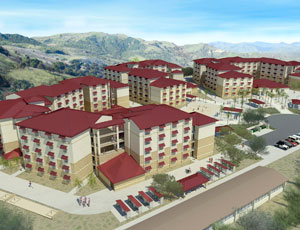As California�s construction industry continues to feel the recession�s pinch, some of the state�s top contractors are tightening their tool belts and concentrating on their company�s individual talents to stay ahead in the game.


SCRIBNER
“The biggest challenge right now is a lot more competition on projects,” says Michael Scribner, president and CEO of San Francisco-based BCCI. “It used to be that we were competing against maybe two or three contractors on a project and now there could be between eight and 10.”
Scribner, whose company specializes in interiors work around the Bay Area, says BCCI is staying busy by improving cost modeling and quality control.
“Our cost-modeling tools have been a big factor in our ability to provide accurate pricing early in the preconstruction phase and ultimately helped us increase backlog year on year by 85% beginning in 2010,” he says. “Another big differentiator is our quality-control program, which has achieved in excess of 31 zero punch-list projects in the last 18 months.”

KEITH
Gavin Keith, project executive with Redwood City-based DPR, agrees the market is “incredibly competitive” and says his company is keeping busy by focusing on core markets such as healthcare.
“Healthcare is the backbone of our backlog going through the next couple years,” says Keith, whose company also specializes in corporate office and manufacturing plant construction. “It is about 40% of our backlog right now, which is more than the usual 25%.”
The company is currently working on the $660-million, 360-bed Pomerado Hospital Palomar Medical Center West in Escondido, one of the largest projects currently under construction in the state, and the $320-million, 230,000-sq-ft Sutter Medical Center in Castro Valley, which will offer 130 acute-care beds and a 34-bed universal care center.
The company is also in preconstruction on the $1.6-billion, 878,000-sq-ft UCSF Medical Center at Mission Bay in San Francisco, which will open in 2014 with 289 beds. Led by Anshen + Allen architects of San Francisco; Cambridge CM Inc. of Palo Alto, project management consultants; and Redwood City’s DPR, the project will utilize building information modeling software and use an integrated project delivery method.

ROGERS
Meanwhile, Dan Rogers, chief operating officer with Santa Clara-based Blach Construction, says his company is keeping pace in an “ultracompetitive market” by “focusing more than ever on our existing client base and maintaining those relationships,” and by concentrating on two markets.
“We are going to stay laser-focused on healthcare and education for the balance of this downturn,” says Rogers, whose company saw its revenue go up about 10% in 2009 and is projecting similar numbers this year.
One of the company’s current projects is a new $27-million, design-build, multidisciplinary classroom building for the San Jose/Evergreen Community College District located on the San Jose City College campus.
The building will include several classrooms for fine arts and ceramics, classrooms for the visual and performing arts programs, staff offices, and miscellaneous site work and landscaping. It is expected to qualify for LEED silver certification.
Another company seeing an increase in business is San Diego-based T.B. Penick & Sons.

LEE
“Amazingly enough, our revenue will be going up in this economy,” says Greg Lee, executive vice president of the company. He says that for 2010 T.B. Penick is projecting about a 15% to 20% increase in revenue over last year.
“We’ve been fortunate enough to take advantage of some markets that are going well right now, such as military build-up around San Diego,” Lee says. “We would be hurting like most firms right now if we didn’t have the military clients.”
He says military work currently makes up about 70% of the firm’s California business.
Current highlights of T.B. Penick’s military work include a $250-million joint venture with Turner Construction at Camp Pendleton in San Diego and a $10-million child care facility at Point Loma Naval base in San Diego, funded by American Recovery and Reinvestment Act.
The Camp Pendleton work includes the construction of more than 1,000 bachelor enlisted quarters in multistory buildings.
“BEQ’s are now more like hotels than they are barracks,” Lee says. “The military is trying to make the living quarters a lot more comfortable for their enlisted folks these days and they are doing a pretty good job of it.”

WELTZ
At Longmont, Colo.-based Flatiron Construction Corp., Curtis Weltz, president of the western region, says his company is pulling through the slow economy by separating itself from the field.
“The only way we can be competitive is by being different,” says Weltz, whose company was recently awarded more than $200 million in transportation projects throughout California. “If we are looking at a bid and can’t answer the question of what makes us different on this job then we really do question why we are bidding it, because the competition is so fierce.”
Flatiron’s biggest project to recently break ground is at the Los Angeles International Airport, where the company has begun a $95-million reconstruction and improvement of Taxi Lane S.
Awarded by the Los Angeles World Airports, the two-year project includes the demolition of several buildings, replacement of existing pavement section, and installation of new airport lighting, storm-drainage system and fueling system. The project broke ground in March.


Post a comment to this article
Report Abusive Comment